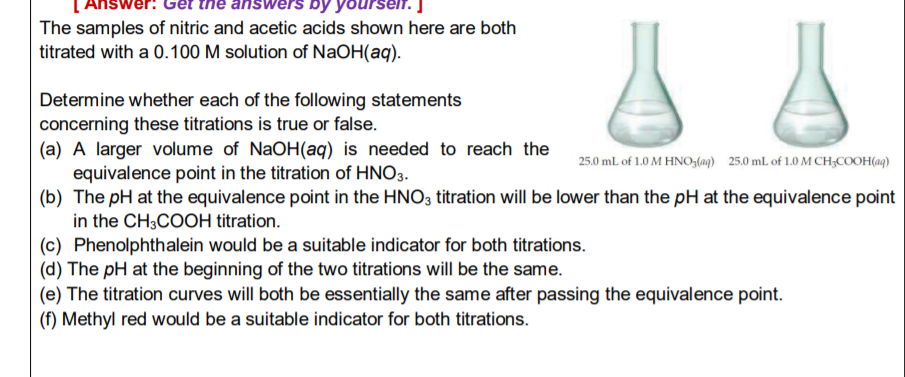The samples of nitric and acetic acids shown here are both titrated with a 0.100 M solution of NaOH(aq). Determine whether each of the following statements concerning these titrations is true or false. (a) A larger volume of NaOH(aq) is needed to reach the equivalence point in the titration of HNO3. (b) The pH at the equivalence point in the HNO3 titration will be lower than the pH at the equivalence point in the CH;COOH titration. (c) Phenolphthalein would be a suitable indicator for both titrations. (d) The pH at the beginning of the two titrations will be the same. (e) The titration curves will both be essentially the same after passing the equivalence point. (f) Methyl red would be a suitable indicator for both titrations. 25.0 mL of 1.0 M HNOzlag) 25.0 mL of 1.0 M CH;COOH(a9)
The samples of nitric and acetic acids shown here are both titrated with a 0.100 M solution of NaOH(aq). Determine whether each of the following statements concerning these titrations is true or false. (a) A larger volume of NaOH(aq) is needed to reach the equivalence point in the titration of HNO3. (b) The pH at the equivalence point in the HNO3 titration will be lower than the pH at the equivalence point in the CH;COOH titration. (c) Phenolphthalein would be a suitable indicator for both titrations. (d) The pH at the beginning of the two titrations will be the same. (e) The titration curves will both be essentially the same after passing the equivalence point. (f) Methyl red would be a suitable indicator for both titrations. 25.0 mL of 1.0 M HNOzlag) 25.0 mL of 1.0 M CH;COOH(a9)
Principles of Modern Chemistry
8th Edition
ISBN:9781305079113
Author:David W. Oxtoby, H. Pat Gillis, Laurie J. Butler
Publisher:David W. Oxtoby, H. Pat Gillis, Laurie J. Butler
Chapter15: Acid–base Equilibria
Section: Chapter Questions
Problem 99AP
Related questions
Question

Transcribed Image Text:Answer: Get the answers by
The samples of nitric and acetic acids shown here are both
titrated with a 0.100 M solution of NAOH(aq).
Determine whether each of the following statements
concerning these titrations is true or false.
(a) A larger volume of NaOH(aq) is needed to reach the
equivalence point in the titration of HNO3.
(b) The pH at the equivalence point in the HNO3 titration will be lower than the pH at the equivalence point
in the CH3COOH titration.
(c) Phenolphthalein would be a suitable indicator for both titrations.
(d) The pH at the beginning of the two titrations will be the same.
(e) The titration curves will both be essentially the same after passing the equivalence point.
(f) Methyl red would be a suitable indicator for both titrations.
25.0 mL of 1.0 M HNOz(ng) 25.0 mL of 1.0 M CH;COOH(aq)
Expert Solution
This question has been solved!
Explore an expertly crafted, step-by-step solution for a thorough understanding of key concepts.
This is a popular solution!
Trending now
This is a popular solution!
Step by step
Solved in 2 steps with 1 images

Knowledge Booster
Learn more about
Need a deep-dive on the concept behind this application? Look no further. Learn more about this topic, chemistry and related others by exploring similar questions and additional content below.Recommended textbooks for you

Principles of Modern Chemistry
Chemistry
ISBN:
9781305079113
Author:
David W. Oxtoby, H. Pat Gillis, Laurie J. Butler
Publisher:
Cengage Learning

Chemistry: Principles and Practice
Chemistry
ISBN:
9780534420123
Author:
Daniel L. Reger, Scott R. Goode, David W. Ball, Edward Mercer
Publisher:
Cengage Learning


Principles of Modern Chemistry
Chemistry
ISBN:
9781305079113
Author:
David W. Oxtoby, H. Pat Gillis, Laurie J. Butler
Publisher:
Cengage Learning

Chemistry: Principles and Practice
Chemistry
ISBN:
9780534420123
Author:
Daniel L. Reger, Scott R. Goode, David W. Ball, Edward Mercer
Publisher:
Cengage Learning


Chemistry: An Atoms First Approach
Chemistry
ISBN:
9781305079243
Author:
Steven S. Zumdahl, Susan A. Zumdahl
Publisher:
Cengage Learning

Chemistry
Chemistry
ISBN:
9781305957404
Author:
Steven S. Zumdahl, Susan A. Zumdahl, Donald J. DeCoste
Publisher:
Cengage Learning

World of Chemistry, 3rd edition
Chemistry
ISBN:
9781133109655
Author:
Steven S. Zumdahl, Susan L. Zumdahl, Donald J. DeCoste
Publisher:
Brooks / Cole / Cengage Learning